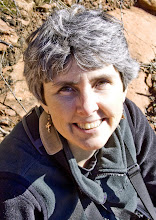First photo, Abandoned Faro, the old lighthouse at the southern tip of the island. The second photo is of the salt paddies, adjacent to the lighthouses.
The southern tip of La Palma, in contrast to the northern tip is quite dry and almost desert. In the mid-eighties, there was a sudden volcanic eruption that spilled lava over about 1/3 of the southern part of the island. Now, the area has been rebuilt and farmers are growing crops, including grapes for wine, out of the shallow dirt on the hillsides.
We traveled down to this area to photograph the lighthouses, but were quite surprised to fine the sea salt "production" in these salt paddies. Sea water is pumped up from the water below. The whole area is on steep cliffs. These shallow pools are carved out of the black lava rock. When the water evaporates, the salt is "harvested" into piles and more sea water is pumped back in. Then, two elderly gentlemen in blue jumpsuits and rubber boots collect the salt and take it into a little shack within the area. There, they bag it. They advertise that the sell the salt and we bought some (at only a euro for a bottle of it), but the two gentlemen have to stop their work to sell to the tourists. Quite an incredible find that doesn't appear to be in any of the guidebooks or advertised.
For every 1000 grams of sea water, only 35 g of sea salt is produced. It's constituent minerals vary by location, but may include calcium, sodium, iodine, and other mineral chlorides.
Both of these shots were taken with a Nikon D70 - no HDR or any special processing. The light and sky were perfect for photography that day.

1 comment:
Just a small correction.
The eruption was in 1971 and sent 2 main lava streams down to the coast through an uninhabited area which is probably less than 1% of the total area of La Palma. Some new land was created on which 2 lighthouses and the salt pans were built. The salt is just a small family business and is mainly sold to shops and supermarkets. It is an essential ingredient papas arugadas, small pototoes cooked in salt. Running the business is not a full time job so stopping to talk and sell to tourists is seen as a pleasant change rather than an inconvenience.
Brian (www.islalapalma.com)
Post a Comment